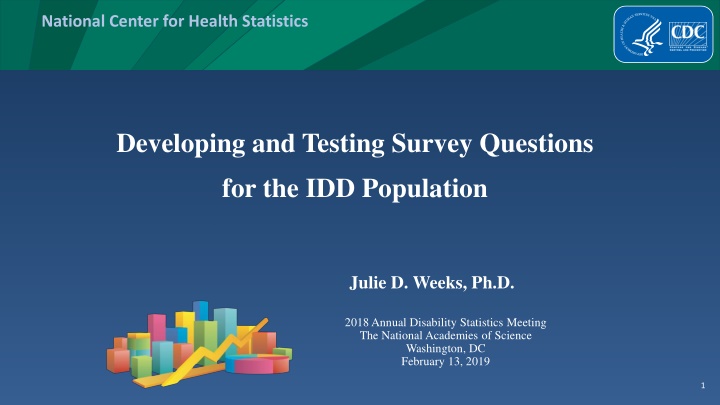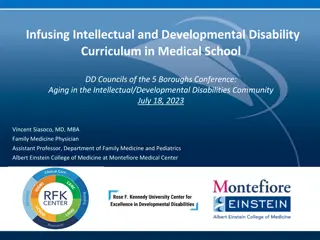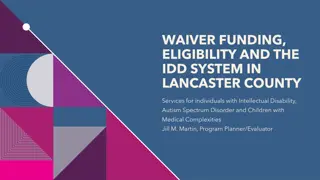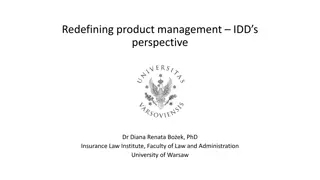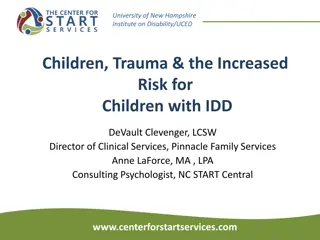Developing and Testing Survey Questions for the IDD Population
Lack of population-level data on individuals with Intellectual and Developmental Disabilities (IDD) poses challenges in collecting consistent and comprehensive statistics. This involves defining IDD, identifying measurement domains, and developing solutions for effective data collection efforts.
Download Presentation

Please find below an Image/Link to download the presentation.
The content on the website is provided AS IS for your information and personal use only. It may not be sold, licensed, or shared on other websites without obtaining consent from the author.If you encounter any issues during the download, it is possible that the publisher has removed the file from their server.
You are allowed to download the files provided on this website for personal or commercial use, subject to the condition that they are used lawfully. All files are the property of their respective owners.
The content on the website is provided AS IS for your information and personal use only. It may not be sold, licensed, or shared on other websites without obtaining consent from the author.
E N D
Presentation Transcript
National Center for Health Statistics Developing and Testing Survey Questions for the IDD Population Julie D. Weeks, Ph.D. 2018 Annual Disability Statistics Meeting The National Academies of Science Washington, DC February 13, 2019 1
State of Statistics on the IDD Population Lack of population-level data Nationally-representative data collected on a regular basis 1994-1995 NHIS on Disability Mechanism for prevalence with regular periodicity Major challenges to collecting the data Varying definitions/measures of IDD serving different purposes diagnostic vs. programmatic vs. surveillance criteria Target population is small Living arrangements group quarters, homes, other institutions Obtaining accurate information from R (self vs. proxy) Language and cultural considerations Person-specific IDD circumstances
Developing a Solution Challenge: To measure the broad experience of IDD using a limited number of questions in a consistently comparable manner. Identify measures needed for data collection efforts 1. Target primarily nationally-representative surveys, but not exclusively 2. Focus on domains where data are not available 3. Functional approach to measurement Develop needed measures 1. Identify currently used measures (if available) 2. Cognitively test existing and new questions
Defining IDD for Data Collection The Developmental Disabilities Assistance and Bill of Rights Act of 2000 defines developmental disability as a severe, chronic disability of an individual that: (i) is attributable to a mental or physical impairment or combination of mental and physical impairments; (ii) is manifested before the individual attains age 22; (iii) is likely to continue indefinitely; (iv) results in substantial functional limitations in 3 or more of the following areas of major life activity: 1. Self-care 2. Receptive and expressive language 3. Learning 4. Mobility 5. Self-direction 6. Capacity for independent living 7. Economic self-sufficiency; and (v) reflects the individual s need for a combination and sequence of special, interdisciplinary, or generic services, individualized supports, or other forms of assistance that are of lifelong or extended duration.
Focusing the Definition of IDD The Developmental Disabilities Assistance and Bill of Rights Act of 2000 defines developmental disability as a severe, chronic disability of an individual that: (i) is attributable to a mental or physical impairment or combination of mental and physical impairments; (ii) is manifested before the individual attains age 22; (iii) is likely to continue indefinitely; (iv) results in substantial functional limitations in 3 or more of the following areas of major life activity: 1. Self-care 2. Receptive and expressive language 3. Learning 4. Mobility 5. Self-direction 6. Capacity for independent living 7. Economic self-sufficiency; and (v) reflects the individual s need for a combination and sequence of special, interdisciplinary, or generic services, individualized supports, or other forms of assistance that are of lifelong or extended duration.
Identifying Existing Questions (ii) is manifested before the individual attains age 22; (iv) results in substantial functional limitations in 3 or more of the following areas of major life activity: 1. Self-care 2. Receptive and expressive language 3. Learning 4. Mobility 5. Self-direction 6. Capacity for independent living 7. Economic self-sufficiency
Identifying Question Development Priorities (ii) is manifested before the individual attains age 22; (iv) results in substantial functional limitations in 3 or more of the following areas of major life activity: 1. Self-care 2. Receptive and expressive language 3. Learning 4. Mobility 5. Self-direction 6. Capacity for independent living 7. Economic self-sufficiency
Using a Functional Approach Focus on limitations in major domains of functioning. Do you have a disability? Do you have difficulty (seeing, hearing, walking, etc.)? Do you have substantial limitation in self-direction? How often are you able to make your own decisions about important things in your every day life, such as where to live, what to eat, and how you spend your free time? Measure environmental barriers separately from limitations.
Importance of Cognitive Testing Question Evaluation Principles: The best question design is based on question evaluation, not expert opinion. Question evaluation is science-based. Evaluation studies must be well documented, replicable, and made accessible. Why conduct question evaluation? To fix problems Ensure comparability Documentation Development and evaluation process What the question captures How resulting data should be used
Goals of Cognitive Testing To what extent are the data elicited from the question a true representation of the phenomena being studied? How do the respondents understand the survey question? Do respondents understand the survey question differently? Does the question mean the same in all the languages that it is asked? Does the question mean the same in all culture and socio-economic groups that it is asked? In processing a question, do all respondents recall information and form an answer the same way?
Question Response Process Social Factors Social Factors Social Factors Retrieval Judgment Response Comprehension Social Factors Social Factors Social Factors Social Factors
Current Testing Activities Administration for Community Living NCHS Collaborating Center for Questionnaire Design and Evaluation Research Questions to be tested, including screener questions Consent forms developed Study design, including 40 Rs (representative in age, race and education) Recruitment strategies, including service providers, advertisements, word of mouth NCHS IRB review of study protocols OMB review of study Target study date: summer 2019
